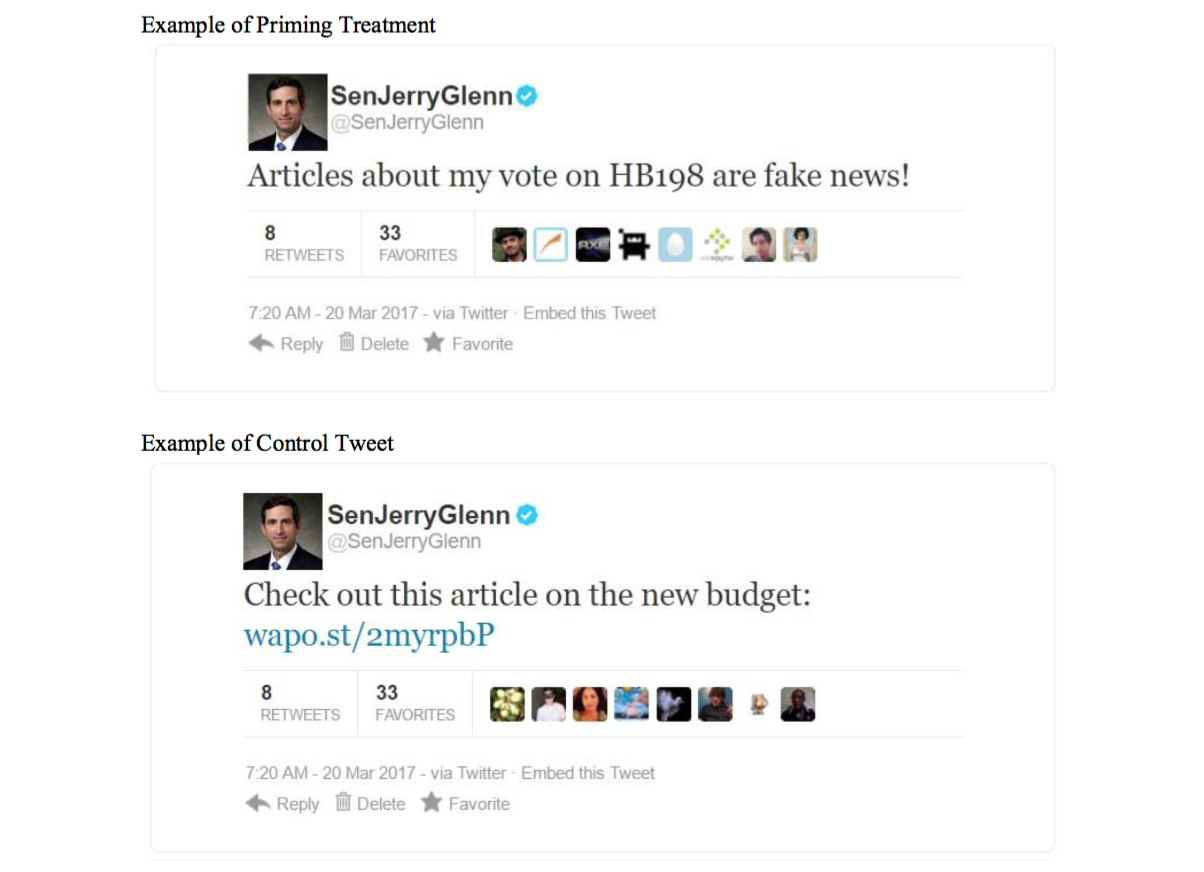Russian trolls? Fake news.
Hate speech? Fake news.
Iranian disinformation? Fake news.
Over the past two years, media organizations have often framed new developments related or adjacent to online misinformation as fake news. While it makes for a good headline, the term has since been weaponized by people ranging from President Donald Trump to Twitter users who use it to leverage attacks against the media.
As a result, “fake news” no longer communicates what journalists often think it does.
In a study published Aug. 15, Emily Van Duyn and Jessica Collier of the University of Texas at Austin found that, when people are exposed to tweets containing the term “fake news,” their ability to tell real from fraudulent stories decreases. Those findings were based on a Mechanical Turk survey of 299 U.S. adults between April and December 2017.
Participants were randomly assigned to one of four conditions in which they were asked to code two sets of nine tweets from “elites" based on their main topics. Then they were shown a story about Trump from a real news outlet like The New York Times or a fake one like The Seattle Tribune. The first variable was manipulated by showing some participants tweets (created by the authors) about topics like the federal budget rather than those about fake news.

Respondents weren’t only exposed to misuses of the term, either — some were shown mock tweets from journalists with headlines about fake news, Van Duyn told Poynter in an email.

After completing a condition, respondents were asked to what extent they trusted the media. Participants who were primed with tweets about fake news expressed less trust than those who weren’t, according to the study.
“We find that exposure to talk about fake news may lower individuals’ trust in media and lead them to identify real news with less accuracy,” the study concludes. “A decline in media trust and a questioning of truth represent important implications for the media’s role in democratic processes.”
As a whole, Van Duyn and Collier’s work confirms what researchers have long thought about the use of the term “fake news” — that it’s been far too weaponized for journalists to continue using it indiscriminately.
“I think this is the first experimental evidence that I have seen that confirms what we have every reason to expect already — if you repeatedly use or report people using a term like fake news, people will understand it in an often different way than the reporters in question,” said Rasmus Kleis Nielsen, director of research at the Reuters Institute for the Study of Journalism, which conducted its own report on how people perceive fake news.
There are alternatives to “fake news.”
In October, First Draft, a project of Shorenstein Center on Media, Politics and Public Policy at the Harvard Kennedy School of Government, published an in-depth report on “information disorder.” Researchers developed a detailed taxonomy, including misinformation, disinformation (“when false information is knowingly shared to cause harm”) and malinformation (“when genuine information is shared to cause harm, often by moving private information into the public sphere.”)
RELATED ARTICLE: Should we stop saying 'fake news'?
And over the past year, some reporters have tried to be more careful and precise when writing about misinformation — even those who helped popularize the term “fake news.”
“We have actually consciously tried to steer clear of the term ‘fake news’ unless it’s in the context of websites that are meant to look like news websites that are publishing false stories,” said Jane Lytvynenko, a reporter for BuzzFeed News. “We prefer to use the term ‘hoax’ or ‘misinformation’ or say something is false.”
In the past, Lytvynenko has received criticism from readers who misinterpreted her work. When she publishes BuzzFeed’s fake news quizzes, some people will respond with insults about the news organization.
“I’ve seen a lot of that term being thrown back at me for sure,” Lytvynenko said. “A lot of the time when I publish that quiz I get people sort of saying, ‘You’re fake news. Why do you think BuzzFeed is not fake news?’”
That misunderstanding is the crux of the problem. It doesn’t mean reporters should never use the term “fake news” — Nielsen said it’s fine for describing specific kinds of misinformation — but they should be more careful about how they’re classifying what they’re writing about.
“I think that when we as reporters write about misinformation or try to correct it, we really need to be aware that there are a lot of people that are not in our world,” Lytvynenko said. “They might not be aware of repeated patterns or intricacies that we know so well. For my reporting, that means taking a bit of extra time to describe something.”







